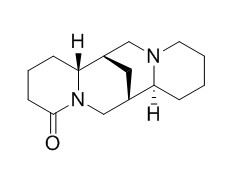Lupanine
Lupanine has a weak sedative effect on the central nervous system, interaction with specific drugs used for treatment of the CNS and for analgesic activity. Lupanine improves glucose homeostasis by influencing KATP-channels of pancreatic beta cells.
Inquire / Order:
manager@chemfaces.com
Technical Inquiries:
service@chemfaces.com
Tel:
+86-27-84237783
Fax:
+86-27-84254680
Address:
1 Building, No. 83, CheCheng Rd., Wuhan Economic and Technological Development Zone, Wuhan, Hubei 430056, PRC
Providing storage is as stated on the product vial and the vial is kept tightly sealed, the product can be stored for up to
24 months(2-8C).
Wherever possible, you should prepare and use solutions on the same day. However, if you need to make up stock solutions in advance, we recommend that you store the solution as aliquots in tightly sealed vials at -20C. Generally, these will be useable for up to two weeks. Before use, and prior to opening the vial we recommend that you allow your product to equilibrate to room temperature for at least 1 hour.
Need more advice on solubility, usage and handling? Please email to: service@chemfaces.com
The packaging of the product may have turned upside down during transportation, resulting in the natural compounds adhering to the neck or cap of the vial. take the vial out of its packaging and gently shake to let the compounds fall to the bottom of the vial. for liquid products, centrifuge at 200-500 RPM to gather the liquid at the bottom of the vial. try to avoid loss or contamination during handling.
Appl. Sci. 2021, 11(22),10569
Int J Pharm.2022, 618:121636.
Phys Chem Chem Phys.2018, 20(23):15986-15994
Preprints2022, 2022030063.
J Pharm Biomed Anal.2019, 172:268-277
In Vivo.2022, 36(3):1136-1143.
Turk J Med Sci.2023 53: 1312-1320.
Int J Mol Med.2016, 37(2):501-8
Molecules.2019, 24(24),4583
Front Cell Dev Biol.2021, 9:638174.
Related and Featured Products
Planta Med. 1987 Oct;53(5):465-9.
Uptake of Lupanine by Alkaloid-Storing Epidermal Cells of Lupinus polyphyllus.[Pubmed:
17269069]
METHODS AND RESULTS:
Epidermis of steins and petioles of LUPINUS POLYPHYLLUS accumulates quinolizidine alkaloids at a concentration of about 30 mM. Since Lupanine is synthesized mainly in green mesophyll tissue and not in the epidermis, the alkaloids have to be transported into the epidermal cells. Uptake of [ (3)H]-Lupanine into isolated epidermis was 3 to 20 times higher in epidermal cells as compared to the corresponding mesophyll cells. Uptake of Lupanine is time dependent and proceeds against a concentration gradient. The uptake depends on temperature and can be characterized by an activation energy of 34 kJ/mol. The process shows multiphasic uptake kinetics and is reduced by SH-group inhibitors (NEM, PHMB) and inhibitors of the energy metabolism (cyanide, antimycine, DNP, CCCP).
CONCLUSIONS:
All these data provide first evidence that simple diffusion cannot be the mechanism for the uptake of Lupanine into epidermal cells. The uptake is probably catalyzed by transport proteins.
J Pharm Pharmacol. 1998 Aug;50(8):949-54.
A comparative study of the effects of sparteine, lupanine and lupin extract on the central nervous system of the mouse.[Pubmed:
9751462]
Lupin is toxic because of its alkaloid content, sparteine and Lupanine in particular. Although the pharmacological properties of sparteine are well known those of Lupanine have not been much studied.
METHODS AND RESULTS:
This paper reports procedures for extraction, purification and crystallization of Lupanine, and methods for the preparation of an extract for injection of Lupinus mutabilis Sweet, and for the determination of the acute toxicity and maximum non-lethal dose (DL0) of Lupanine, sparteine and lupin extract in the mouse. The three substances were tested on the central nervous system (CNS) for locomotor activity, for interaction with specific drugs used for treatment of the CNS (the stimulant drugs amphetamine and pentetrazol and the depressant drugs pentobarbital and chlorpromazine) and for analgesic activity.
CONCLUSIONS:
The results indicate that Lupanine and lupin extract are less toxic than sparteine and that at the doses studied the three products have a weak sedative effect on the CNS.
Molecules. 2015 Oct 20;20(10):19085-100.
Lupanine Improves Glucose Homeostasis by Influencing KATP Channels and Insulin Gene Expression.[Pubmed:
26492234 ]
The glucose-lowering effects of lupin seeds involve the combined action of several components. The present study investigates the influence of one of the main quinolizidine alkaloids, Lupanine, on pancreatic beta cells and in an animal model of type-2 diabetes mellitus.
METHODS AND RESULTS:
In vitro studies were performed with insulin-secreting INS-1E cells or islets of C57BL/6 mice. In the in vivo experiments, hyperglycemia was induced in rats by injecting streptozotocin (65 mg/kg body weight). In the presence of 15 mmol/L glucose, insulin secretion was significantly elevated by 0.5 mmol/L Lupanine, whereas the alkaloid did not stimulate insulin release with lower glucose concentrations. In islets treated with l-arginine, the potentiating effect of Lupanine already occurred at 8 mmol/L glucose. Lupanine increased the expression of the Ins-1 gene. The potentiating effect on secretion was correlated to membrane depolarization and an increase in the frequency of Ca(2 ) action potentials. Determination of the current through ATP-dependent K⁺ channels (KATP channels) revealed that Lupanine directly inhibited the channel. The effect was dose-dependent but, even with a high Lupanine concentration of 1 mmol/L or after a prolonged exposure time (12 h), the KATP channel block was incomplete. Oral administration of Lupanine did not induce hypoglycemia. By contrast, Lupanine improved glycemic control in response to an oral glucose tolerance test in streptozotocin-diabetic rats.
CONCLUSIONS:
In summary, Lupanine acts as a positive modulator of insulin release obviously without a risk for hypoglycemic episodes.



